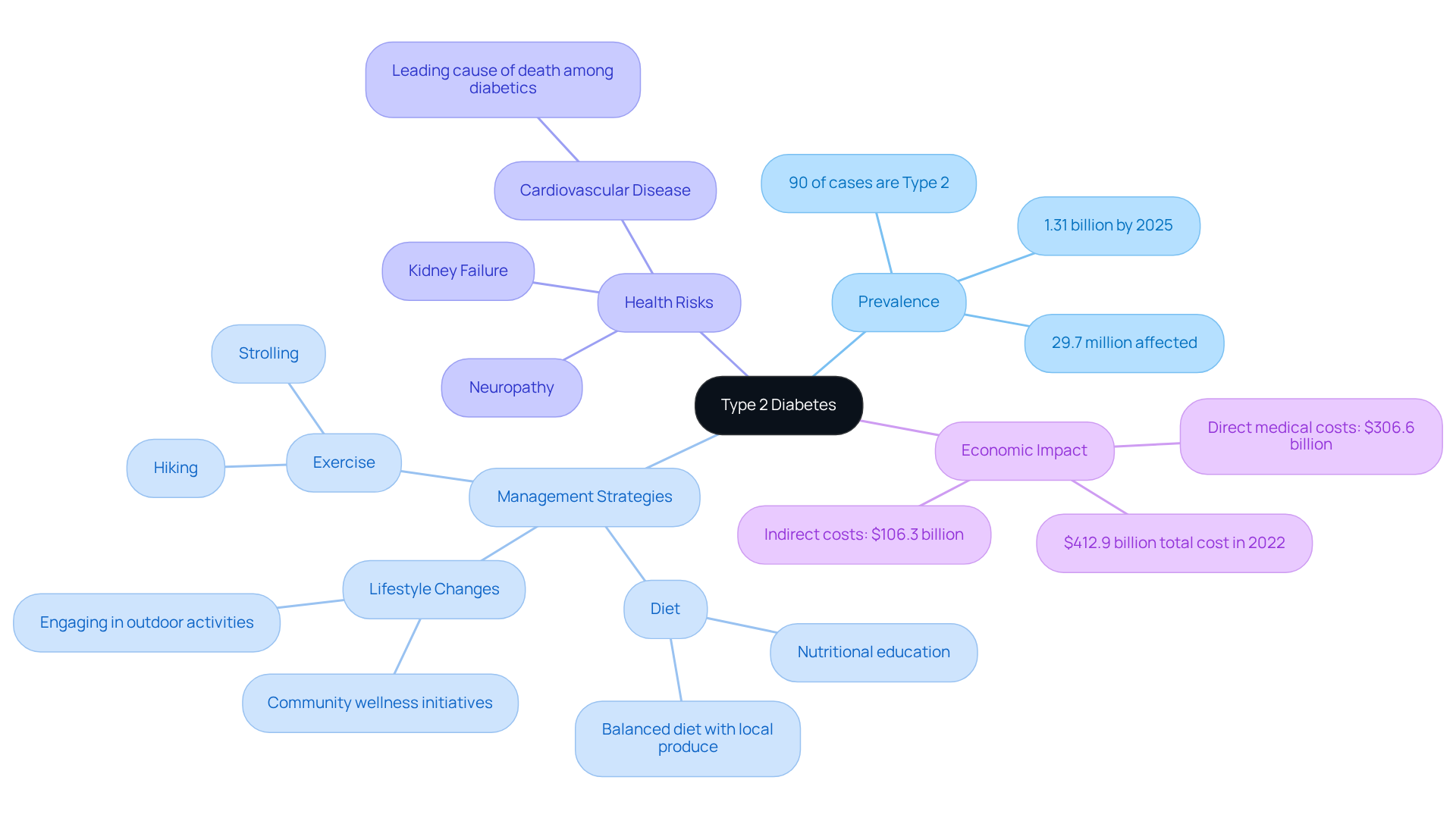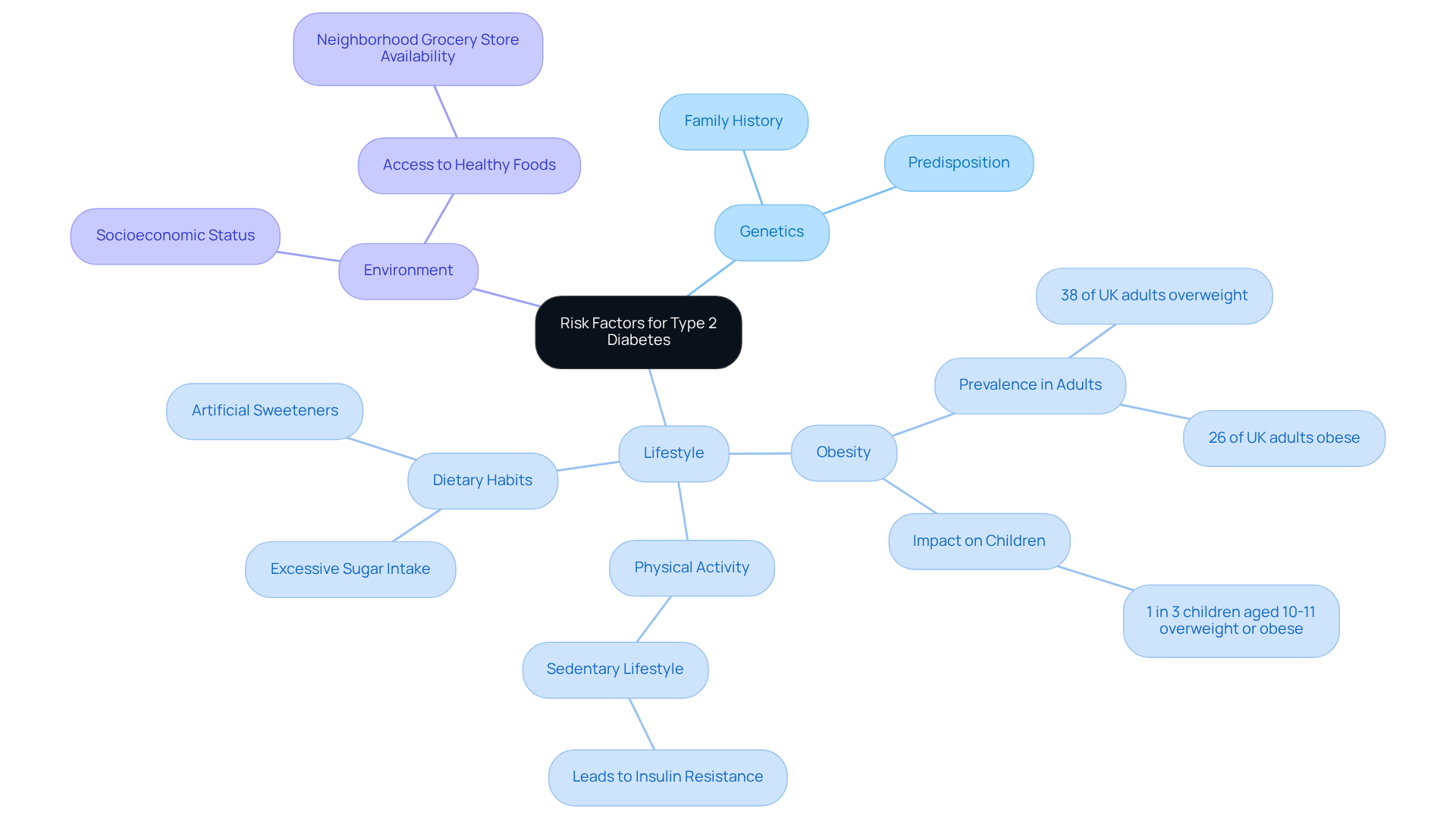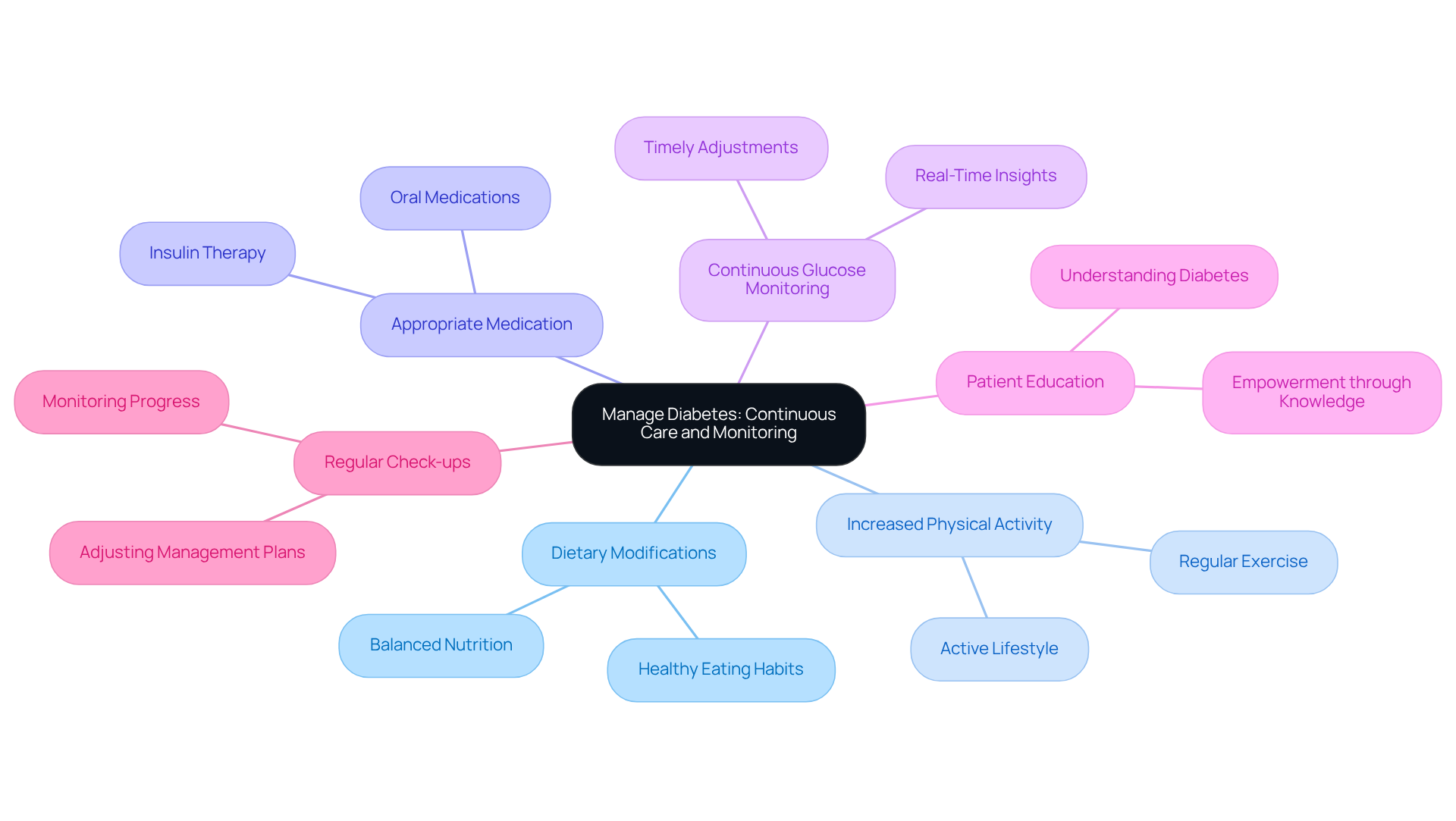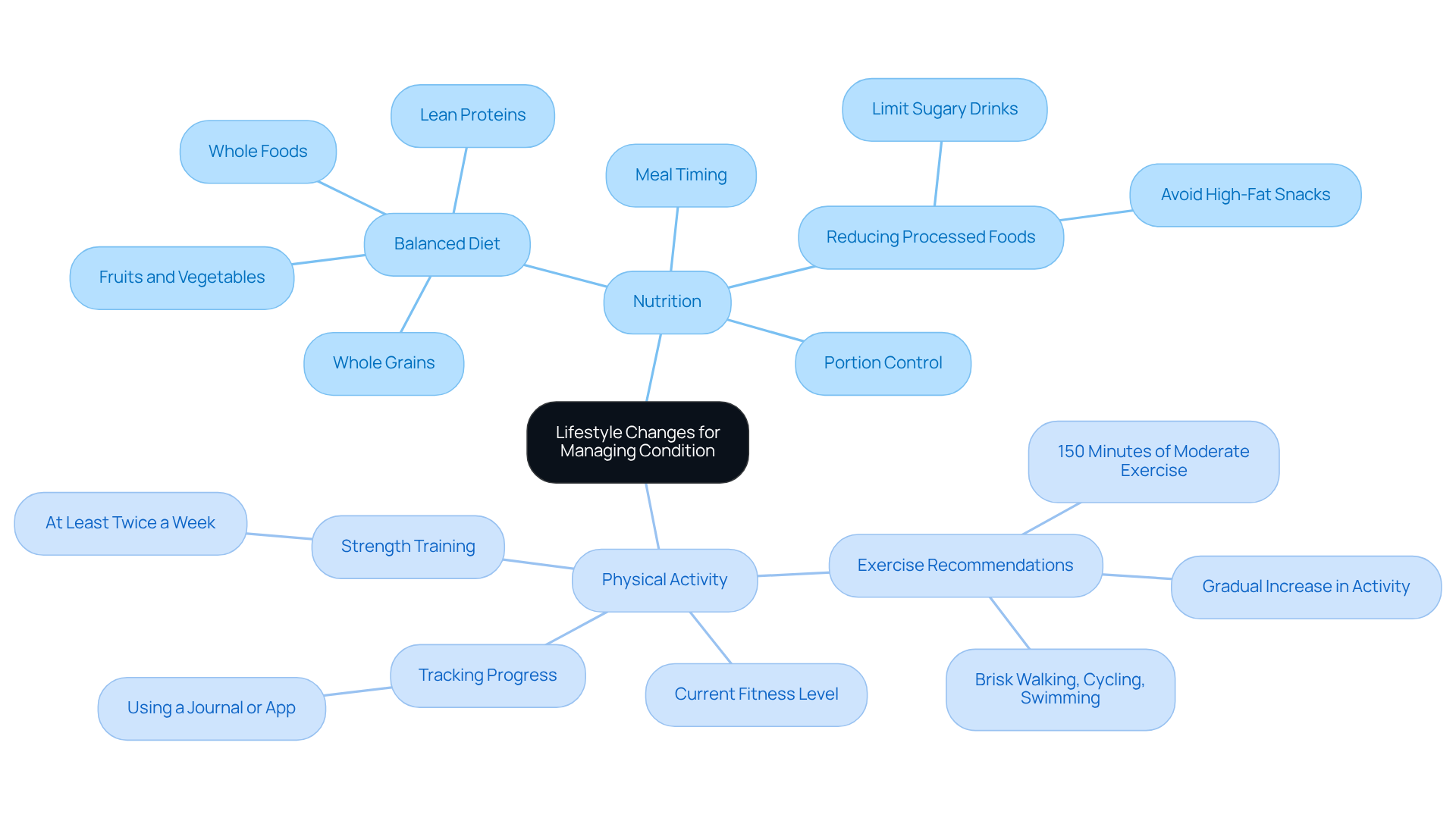Overview
Type 2 diabetes can feel overwhelming, and it’s important to recognize that several key risk factors—such as genetics, lifestyle choices, and environmental conditions—play a significant role in your likelihood of developing this condition. Many patients find that understanding these factors can be the first step toward taking control of their health. Proactive management through lifestyle changes, like adopting a healthier diet and increasing physical activity, is essential in mitigating these risks.
It’s crucial to remember that you are not alone in this journey. By making these changes, you can effectively manage diabetes and improve your overall well-being. We must highlight the urgent need for public health interventions, but personal responsibility also plays a vital role. What steps can you take today to start your journey toward a healthier lifestyle? Together, we can navigate these challenges and find supportive pathways to better health.
Introduction
The rising incidence of Type 2 diabetes is a pressing public health concern that affects many individuals and families. Projections indicate that by 2025, over 1.31 billion people worldwide could be impacted. This chronic condition brings significant health risks, such as cardiovascular disease and kidney failure, and it also creates an immense economic burden on our healthcare systems.
It’s important to recognize that understanding the multifaceted risk factors—ranging from genetics and lifestyle choices to environmental influences—can empower individuals and communities to implement effective management strategies.
How can proactive lifestyle changes and continuous care reshape the trajectory of this growing epidemic? By taking small, meaningful steps, we can work together to foster a healthier future.
Define Type 2 Diabetes: Prevalence and Significance
Type 2 diabetes is a chronic metabolic condition characterized by insulin resistance and elevated blood glucose levels. It’s important to recognize that in the United States, around 29.7 million people are living with this condition, with the second form accounting for over 90% of these instances. Since 1990, the World Health Organization (WHO) has reported a staggering four-fold increase in global cases, projecting that by 2025, approximately 1.31 billion individuals will be affected. This alarming trend highlights the urgent need for effective management strategies and public health interventions.
Managing life with Type 2 diabetes in San Marcos, CA, can be approached effectively through lifestyle adjustments that resonate with the local environment. Many patients find that engaging in outdoor activities, such as hiking at Lake San Marcos or strolling the paths at Discovery Lake, can greatly enhance insulin sensitivity and assist in weight management—both vital for controlling Type 2 diabetes. Consistent physical exercise not only boosts mood but also aids in blood sugar regulation, making it an essential component of managing this condition. Incorporating a balanced diet rich in local produce, like avocados and berries, is crucial for maintaining healthy blood sugar levels. Participating in community wellness initiatives can provide essential support, offering resources designed to help manage health conditions while enjoying the beautiful surroundings of San Marcos.
The impact of insulin resistance on public health is significant, contributing to complications such as cardiovascular disease, kidney failure, and neuropathy. In fact, cardiovascular disease is the leading cause of death among diabetics, accounting for 50-60% of fatalities. Early intervention is key, as it can prevent or delay the onset of these complications. Research shows that lifestyle changes, including nutrition and physical activity, can considerably reduce the risk of developing chronic glucose intolerance, particularly among high-risk groups.
Expert opinions emphasize the importance of proactive management of blood sugar levels. The Centers for Disease Control and Prevention (CDC) notes that nearly 38% of U.S. adults have prediabetes, a condition that often precedes Type 2 diabetes. Addressing prediabetes through education and lifestyle changes can significantly alter the trajectory for those at risk. Furthermore, the economic burden of this condition is staggering, with the total cost of diagnosed cases in the U.S. reaching $412.9 billion in 2022, underscoring the need for comprehensive healthcare strategies.
For personalized guidance and support tailored to your unique needs, consider reaching out to Dr. Jason Shumard in San Marcos, CA. Our expert team is dedicated to assisting you in managing your condition with care and expertise. In summary, understanding the prevalence and significance of Type 2 diabetes is crucial for both individuals and healthcare providers. It emphasizes the importance of early intervention and ongoing care to alleviate the challenges associated with this chronic condition.
Identify Risk Factors: Genetics, Lifestyle, and Environment
The factors contributing to the development of type 2 diabetes can be understood through three main lenses: genetics, personal habits, and environmental influences. It’s essential to recognize that genetic predisposition plays a significant role; individuals with a family history of this condition face a heightened risk. However, habits such as obesity, lack of physical activity, and unhealthy eating are within our control and significantly influence the onset of this condition. For instance, obesity has become a pressing epidemic, with nearly three in five Americans classified as overweight, which substantially increases their risk of developing type 2 diabetes. Moreover, a sedentary lifestyle can lead to insulin resistance, further raising the likelihood of this condition. Alarmingly, about one in three children aged 10 to 11 are considered overweight or obese, highlighting the troubling rise in obesity rates among our youth—a major factor contributing to type 2 diabetes.
Environmental factors also play a crucial role in the likelihood of developing this condition. Socioeconomic status and access to healthy food options are vital; neighborhoods that lack grocery stores often experience higher rates of obesity and diabetes. In the UK, around 26% of adults are classified as obese, with projections indicating that by 2040, over 70% of adults could be overweight or obese if current trends persist. This concerning trend underscores the importance of understanding these risk factors, as it empowers individuals to make informed lifestyle choices. Additionally, obesity imposes a significant financial burden on the NHS, costing an estimated £6.5 billion annually, which highlights the broader economic implications of these health challenges.
To combat these issues, engaging in regular physical activity, such as following a structured walking program, and maintaining a balanced diet are essential steps. A thoughtful approach to starting a walking routine includes:
- Assessing your current fitness level
- Setting achievable goals
- Gradually increasing both the duration and frequency of your walks
Dr. Jason Shumard’s Integrative Wellness Center offers valuable resources like the 30-Day Diabetes Reset Program, providing practical solutions for those eager to reclaim their health. Additionally, educational materials, including Dr. Shumard’s books, offer insightful guidance on reversing the condition and achieving better health outcomes. By focusing on lifestyle changes, individuals can significantly reduce their risk of developing chronic conditions and enhance their overall health and vitality.
Manage Diabetes: Continuous Care and Monitoring
Successfully managing this condition can feel overwhelming at times, but it’s important to recognize that a comprehensive strategy can make a significant difference. Ongoing care and consistent tracking of blood glucose levels are essential. Patients are encouraged to collaborate closely with their healthcare providers to create personalized management plans. These plans should include:
- Dietary modifications
- Increased physical activity
- Appropriate medication
Many patients find that continuous glucose monitoring (CGM) systems are invaluable in this process. They offer real-time insights into blood sugar fluctuations, allowing for timely adjustments to treatment strategies. Regular check-ups are crucial for evaluating the success of these management plans and making necessary changes.
It’s also vital to empower individuals through patient education. Understanding your condition and the significance of adhering to management protocols can foster a sense of ownership over your health journey. This holistic approach not only improves the management of the condition but also nurtures a deeper connection to one’s well-being. Remember, you are not alone in this journey—support is available, and taking these steps can lead to a healthier, more fulfilling life.
Implement Lifestyle Changes: Nutrition and Physical Activity
Making changes to your lifestyle is essential for managing condition 2 effectively. Have you ever considered how a balanced diet, rich in whole foods like fruits, vegetables, whole grains, and lean proteins, can help regulate your blood sugar levels? It’s important to recognize that reducing your intake of processed foods, sugary drinks, and high-fat snacks is just as vital. Additionally, practicing portion control and paying attention to meal timing can significantly impact your blood sugar management.
Many patients find that alongside dietary adjustments, regular physical activity plays a crucial role. Start by evaluating your current fitness level and choosing a safe, comfortable environment for walking. Aim for at least 150 minutes of moderate-intensity exercise each week, whether it’s brisk walking, cycling, or swimming. Gradually increase the duration and frequency of your walks over time, aiming for a daily commitment of just 10-15 minutes. Incorporating strength training exercises at least twice a week can also enhance your insulin sensitivity.
Tracking your progress with a journal or an app can be a wonderful way to maintain motivation and celebrate your achievements. Did you know that studies indicate individuals in health modification programs experience a 58% reduced occurrence of type 2 diabetes after achieving a 5 to 7% weight reduction? Furthermore, organized walking initiatives have an impressive success rate of 89.5%, highlighting the effectiveness of structured walking programs.
By embracing these lifestyle changes, including personalized nutrition plans and regular physical activity, you can significantly lower your risk of complications and enhance your overall health. This journey not only leads to an improved quality of life but also reduces reliance on conventional medical interventions. Remember, you are not alone in this; there is support available every step of the way.
Conclusion
Understanding Type 2 diabetes is crucial, as it highlights the urgent need for effective management strategies due to the increasing prevalence of this chronic condition. It’s important to recognize that Type 2 diabetes not only affects millions globally but also poses significant health risks, including cardiovascular diseases and complications that can severely impact quality of life. Many patients find that recognizing the importance of early intervention and ongoing care is essential for both individuals and healthcare providers in addressing this growing public health concern.
Key insights from the article reveal that lifestyle factors, genetic predisposition, and environmental influences play pivotal roles in the development of Type 2 diabetes. The discussion on risk factors underscores the significance of making informed lifestyle choices. Engaging in regular physical activity and adopting a balanced diet are vital steps to mitigate risks. Furthermore, the economic burden of diabetes management reinforces the necessity for proactive healthcare strategies and community support to empower individuals in their health journeys.
Ultimately, the message is clear: managing Type 2 diabetes requires a comprehensive approach that includes:
- Lifestyle modifications
- Continuous monitoring
- Patient education
By prioritizing these strategies, individuals can significantly lower their risk of complications and enhance their overall well-being. It is imperative to take action now, whether through personal commitment to healthier habits or by seeking support from healthcare professionals. Together, we can combat the rising tide of Type 2 diabetes and foster a healthier future for all.
Frequently Asked Questions
What is Type 2 diabetes?
Type 2 diabetes is a chronic metabolic condition characterized by insulin resistance and elevated blood glucose levels.
How prevalent is Type 2 diabetes in the United States?
Approximately 29.7 million people in the United States are living with Type 2 diabetes, which accounts for over 90% of diabetes cases.
What has been the trend in global cases of Type 2 diabetes?
Since 1990, there has been a four-fold increase in global cases of Type 2 diabetes, with projections indicating that around 1.31 billion individuals will be affected by 2025.
How can lifestyle adjustments help manage Type 2 diabetes in San Marcos, CA?
Patients can engage in outdoor activities like hiking and walking, which enhance insulin sensitivity and assist in weight management. A balanced diet rich in local produce is also crucial for maintaining healthy blood sugar levels.
What are the complications associated with insulin resistance?
Insulin resistance can lead to serious complications such as cardiovascular disease, kidney failure, and neuropathy, with cardiovascular disease being the leading cause of death among diabetics.
What role does early intervention play in managing Type 2 diabetes?
Early intervention can prevent or delay the onset of complications associated with Type 2 diabetes, making it essential for effective management.
What percentage of U.S. adults have prediabetes?
Nearly 38% of U.S. adults have prediabetes, which often precedes Type 2 diabetes.
What is the economic impact of Type 2 diabetes in the U.S.?
The total cost of diagnosed cases of Type 2 diabetes in the U.S. reached $412.9 billion in 2022, highlighting the need for comprehensive healthcare strategies.
Who can provide personalized guidance for managing Type 2 diabetes in San Marcos, CA?
Dr. Jason Shumard and his expert team in San Marcos, CA, offer personalized guidance and support for managing Type 2 diabetes.



